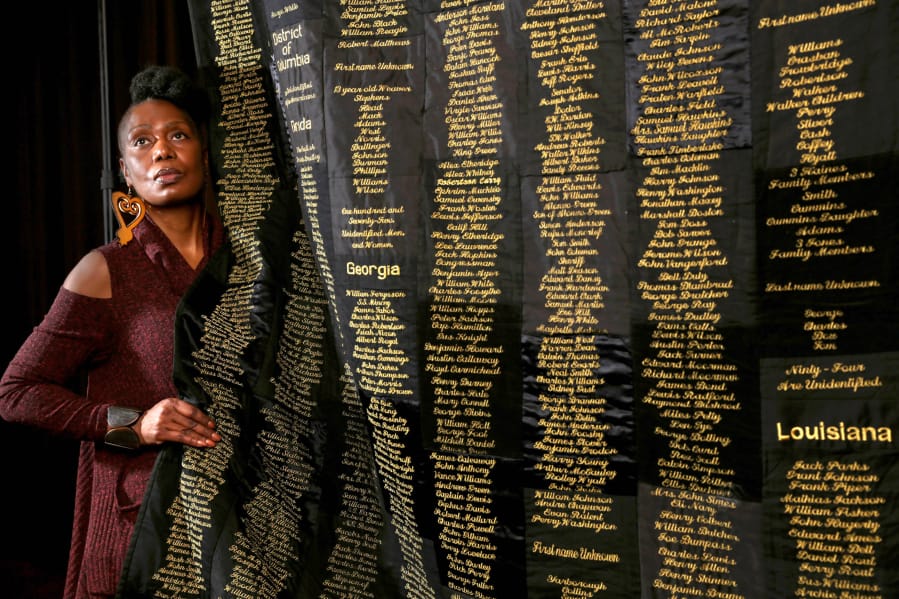DETROIT — The quilter’s fabric is soft, her stitches shine with golden thread and the setting for seeing her handiwork is the stillness of a church.
Yet, viewers can’t help but be jarred because, attached to the top of this 10- by 10-foot piece of black cloth, a pair of full-sized hang nooses seem to leer in bitter tribute to the countless African-Americans who died at the hands of lynch mobs.
Beneath the nooses, quilter April Shipp from suburban Detroit stitched thousands of names of African-Americans, all known to have lost their lives to mobs, most on the end of a hang noose, some by other means including being tied to a tree and burned alive. Shipp did the research, extracting names that she calls “my 5,000 souls” from news stories about each murder, compiled by historians in books she acquired.
“It’s terrible to think about, but they’re resting now, and they live on in my cloth,” Shipp said.
Her beautiful tribute to cruelty took its place recently amid nearly 60 other quilts, most sewn in bright cheery colors, in the annual show of quilts unfurled each February at Detroit Unity Temple. Each quilter in the church’s audience — including some from other churches, others who submitted work through quilting societies — was asked to stand “and be acknowledged for their beautiful work” during a Sunday service, said the Rev. Gregory Guice, the church’s pastor.
In observing African-American history month, metro-Detroit’s black quilters said their tradition speaks to the homespun history of American slaves, forced to stitch makeshift fabric from scraps of their masters’ cloth.
“And they a lot of times used this to send a message — that’s why we have several, what we call, protest quilts in this show,” said Shirley Phillips-Horne, 80, of Detroit, a church member and co-organizer of the quilt show.
One protest quilt has, stapled to it, the actual paper receipt for the last poll tax paid by the quilter’s grandmother in the early 1960s — remnant of a barrier to voting for generations of blacks in the South.
The stitches in Shipp’s quilt bear witness to a more sordid history, stopping viewers in their tracks.
Patchwork of names
Shipp said she named her soft, shining testament to cruelty after a song about lynching by jazz legend Billie Holiday. Embroidered atop her quilt are the words “Strange Fruit — a Century of Lynching and Murder, 1865 to 1965.”
She listed victims state by state. Under the southern states, the rosters seem endless, with names that suggest macabre cruelty. Brothers were hanged together, mothers and their children strung up side by side, Shipp said.
Under Michigan, only two names shine in gold thread. Beneath the names Eddie Cook and Albert Martin, her quilt reads “And twenty seven others unnamed.” Among those 27 unnamed victims, Shipp included 25 blacks who — according to news stories of the time — were killed by roving mobs and by police during Detroit’s race riot of June 1943.
Shipp’s quilt has been displayed at several museums around the country, including Detroit’s Charles H. Wright Museum of African-American History, although its permanent home is in her house, she said.
“This took me three years,” said Shipp, 55, a native of Detroit who lives in Rochester Hills.
By day, she’s a shop assistant for Fiat-Chrysler of America in an auto-research lab in Auburn Hills. After hours, she sews and is known for it. Recently, Shipp turned out 100 black armbands for officers in mourning to wear at the funeral of slain Detroit police officer Glenn Doss.
Recently, she was at Detroit Unity Church to assist in mounting the church’s quilt show. Quilts are a handicraft sewn throughout history by people of all races; historians say the process of sewing two or more layers of fabric together to make a thicker, padded material goes back thousands of years.
Still, African-Americans say they have a special fondness for quilting. One recent trend? Using cloth made in Africa, said Cynthia Ferguson, a Detroiter who imports quilt-sized swatches in bright designs from Mali and Ghana, then sells them to Detroit-area quilters. Ferguson, calling her business Fergie’s International Fabrics, had tables of fabric on display for a quilters’ workshop held after the church service.
Like most quilters, African Americans habitually fashioned patterns with a technique called “patchwork quilting” — using scraps of cloth in various shapes and multiple layers to create bedding, and sometimes to make clothing or purses. Although Shipp’s “Strange Fruit,” with its all-black background, appears not to be a patchwork design, it is.
“You have to look close-up. See, I used different types of black cloth to show the different walks of life these people were from.
“Because you could be anyone and get lynched,” Shipp said.



